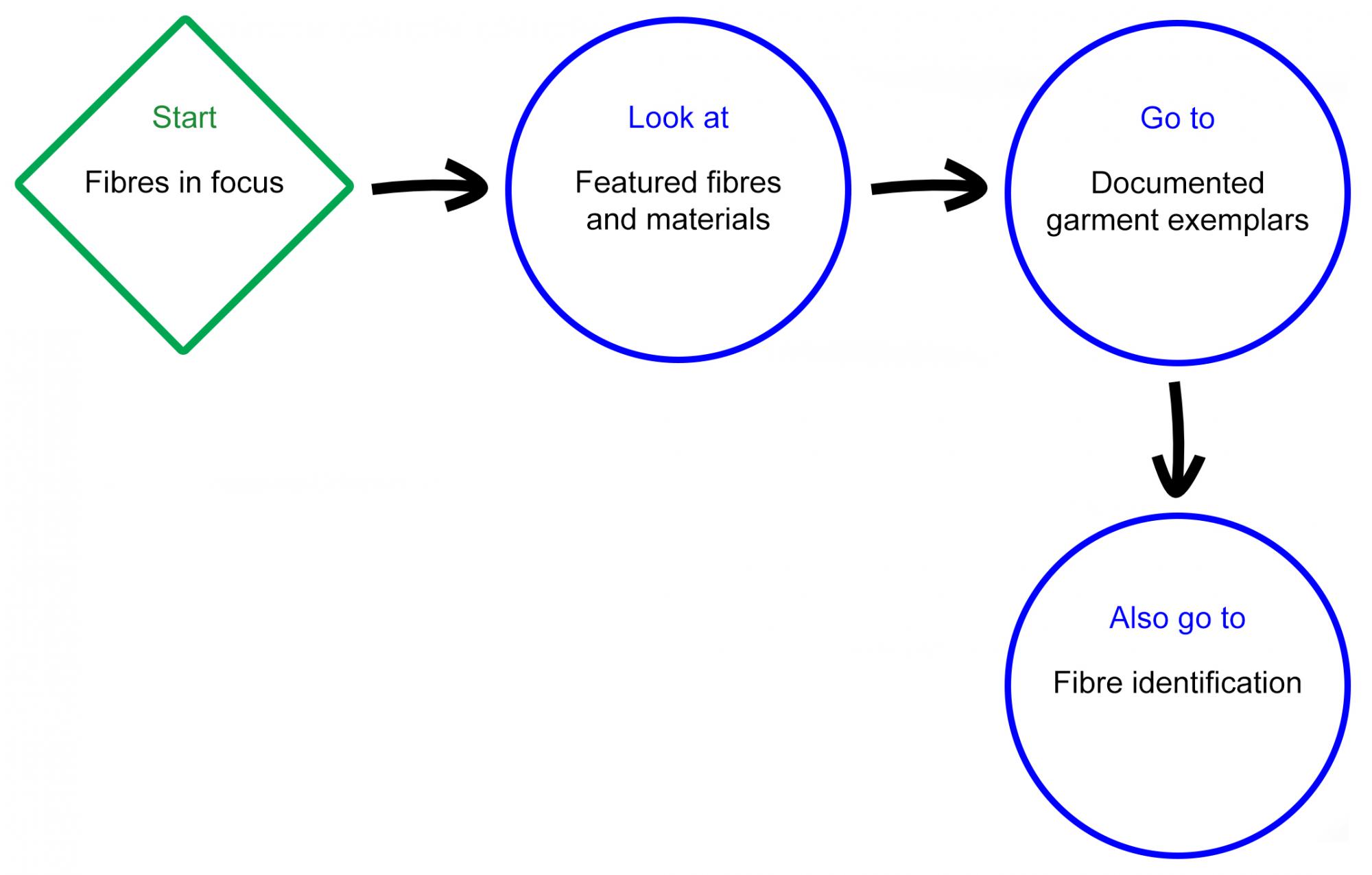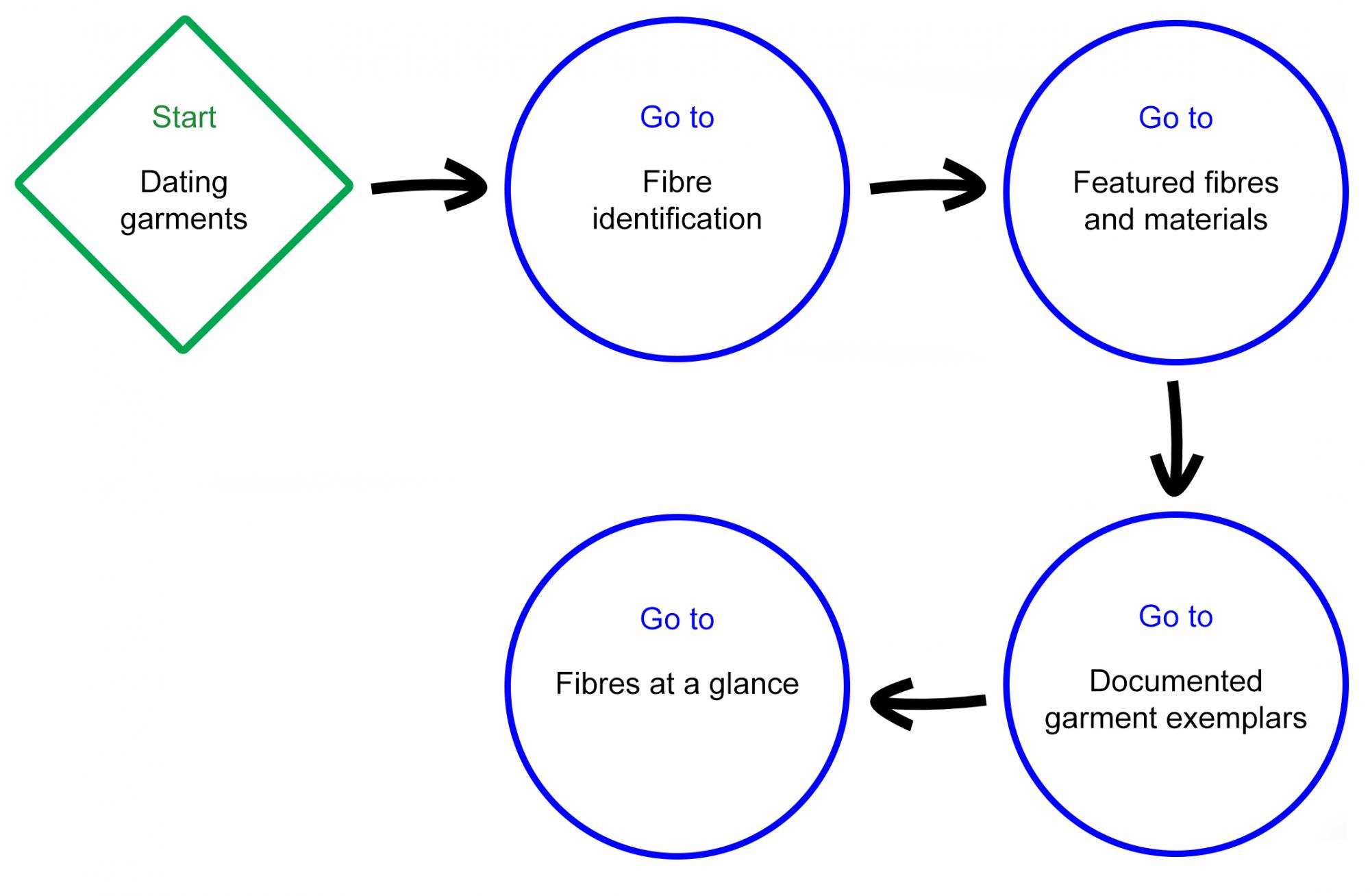There are many ways of using this guide. It can be read like a book or manual from beginning to end but it is likely that often users will be especially interested in particular aspects or looking to answer specific questions. If this is the case, it will still help to familiarise yourself with its structure, but we have identified five paths through its sections, some more obvious than others, in keeping with the Guide’s aims.
The guide can also be searched. Searches made on the website will search the whole website thus will bring up entries not only within this resource but on the website as a whole. If you wish to restrict your search to this resource please search the DATS version downloadable from the home page.
If you find passages or diagrams you think you may wish to refer to often, you are welcome to copy and paste them. For example if you would like to have the information on Care and degradation provided in Featured fibres and materials more easily to hand just copy them to where is convenient for you, either within the downloadable version or make a document of your own. Equally, you may like to collect all the diagrams together into a single document. Please note, however, that requests to use the images of the documents should be made directly to the relevant collection.
Some terms used may not be familiar to all users. Terms are explained in the Glossaries. If you need information on a term not featured, please let us know at modip@aub.ac.uk, so that we can add an explanation for it.
Understanding semi and fully synthetic fibres

This path introduces the science underpinning the creation of semi and synthetic fibres, how they are created, the character of different fibres and the issues they raise, and how and in what kind of garments they are used.
Start with Fibres in focus: whole section until you reach Featured fibres and materials, then limit yourself to the fibres of particular interest to you.
Then go to Documented garment exemplars: look just at the entries for garments made from the fibres of particular interest to you. Fibre entries in Featured fibres and materials are cross-referred to the documented garments containing them at the bottom of the page of each fibre
You may also like to look at information about these fibres in the Fibres under the microscope section of Fibre identification.
Semi and fully synthetic fibre identification

This path provides guidance on the identification of the fibre(s) in a particular piece of fabric.
Start with Dating garments: this section should help you place your garment within a date range. It includes a fibre timeline which enables you to see quickly when potential fibres became commercially available, thus whether their existence falls within the date range of your garment.
Go to Fibre identification: and look at the introduction; Sight and touch; and Fibre and care labels.
Go to Featured fibres and materials: look at the fibre types you think could be the fibre in your garment to find out more about the different potential fibres’ characteristics.
Go to Documented garment exemplars: look just at the entries for garments including the fibres of particular interest to you. Fibre entries in section 3 are cross-referred to the documented garments containing them. You will be able to compare your garment with garments fibres that have been identified through scientific analysis.
Go to Fibres at a glance: once you have identified, or potentially identified your fibre, these tables give the various, generic, common and trade names the fibre is known by. We have opted to call the fibre by the generic name given in bold in the first column of information about each fibre type.
Documenting semi and fully synthetic garments

This path provides guidance on ways to find required information and good practice.
Start with Good documentation practice: tips, pitfalls and good practice guidance on fibre identification, country of production, labels and measurements. It also leads you to other in-depth information in other parts of the toolkit.
Go to Dating garments for tips on dating garments.
Go to Documented garment exemplars: an extensive range of documented garments as examples of good practice.
Care of semi and fully synthetic garments

This path provides guidance on the care of semi and fully synthetic garments in the museum environment.
Start with Caring for synthetic garments: guidance on environmental conditions, storage, handling and display, and examples of degradation.
Go to Featured fibres and materials. Look at the entry: Care and degradation under the fibre types of concern to you.
Go to Documented garment exemplars: look only at garments including fibre types of concern to you. Fibre entries in Featured fibres and materials are cross-referred to the documented garments containing them.
Display narratives

This path provides ideas of ways to engage the public with the synthetic garments in your collection.
Start with Potential narratives and research areas: consider the garments you wish to display in relation to the subject areas outlined.
Go to fibres of interest to you in Featured fibres and materials and look at the suggested Potential narratives.
You can also search the guide under headings of interest. It will also bring up fibres in Featured fibres and materials: here you will find narrative ideas relating specifically to those fibres. Consider these ideas against the garments in your collection.
